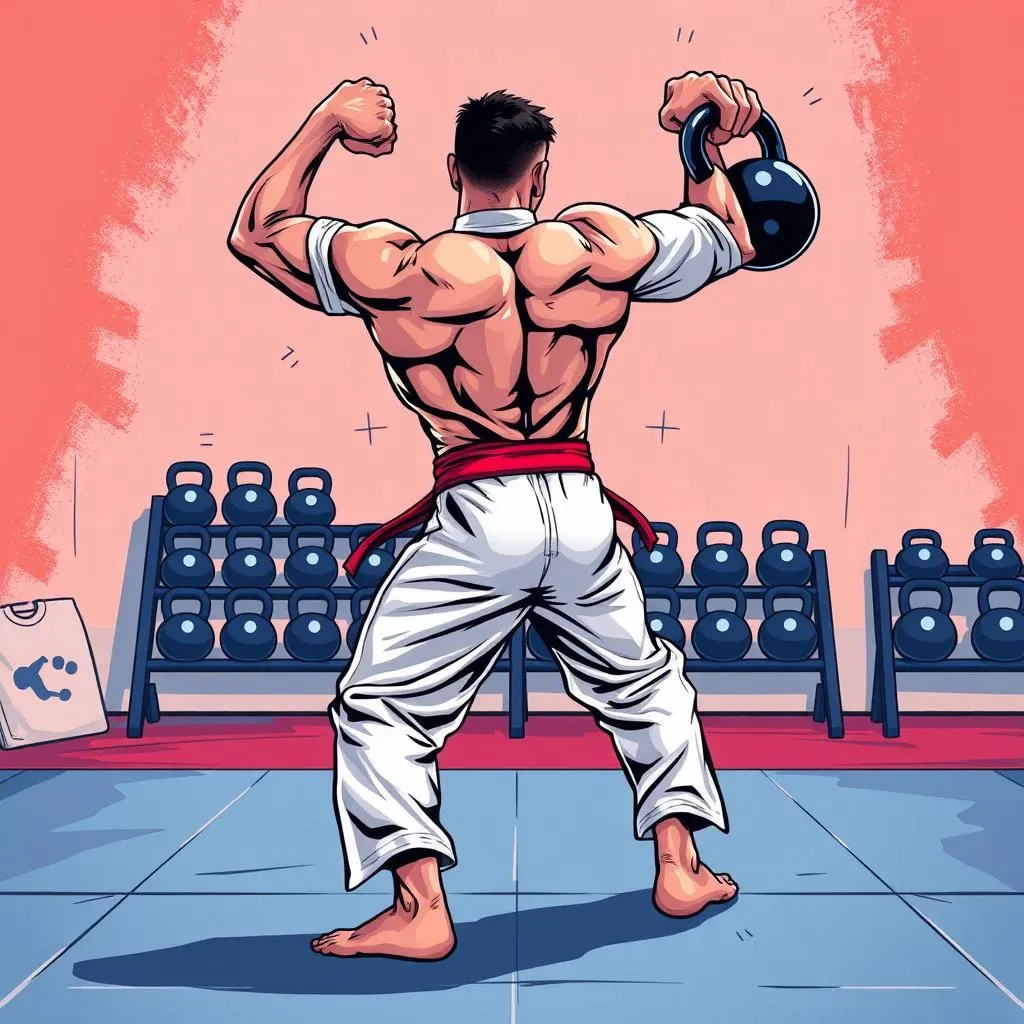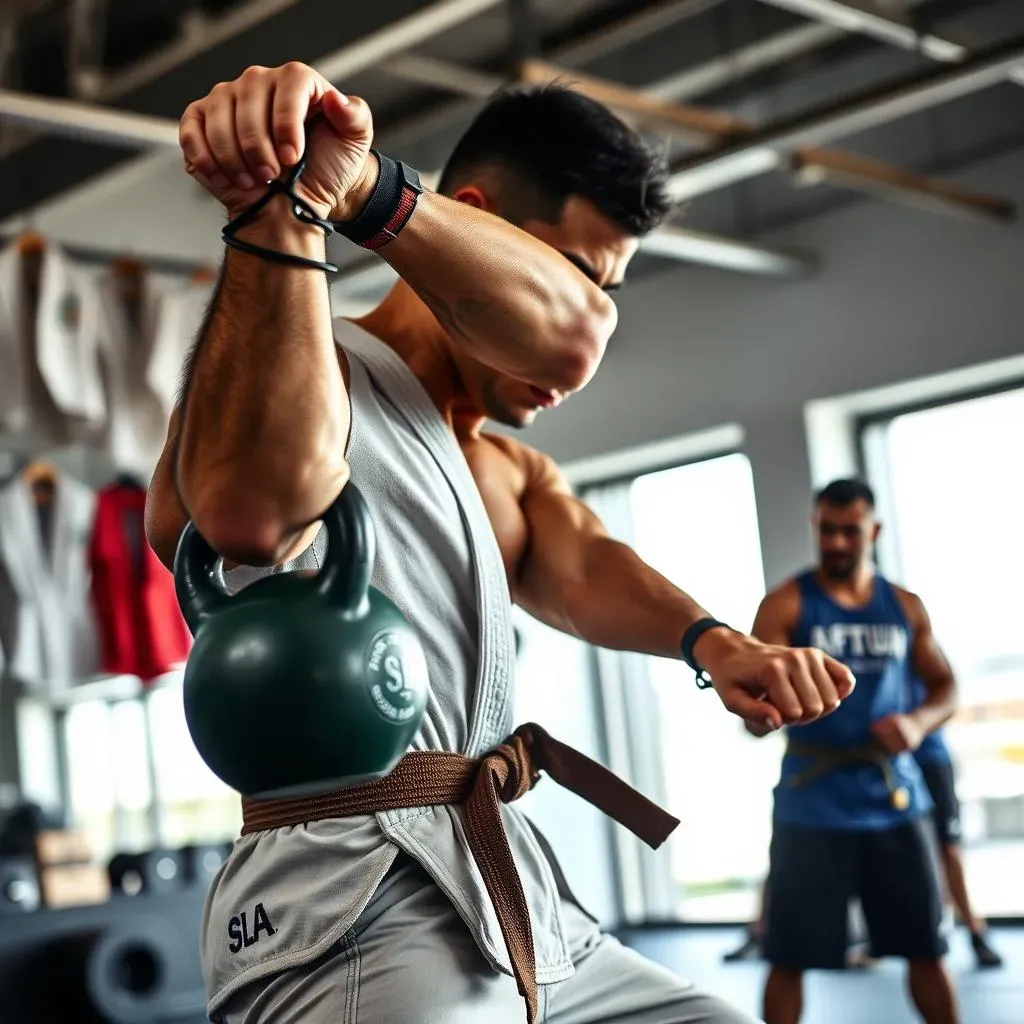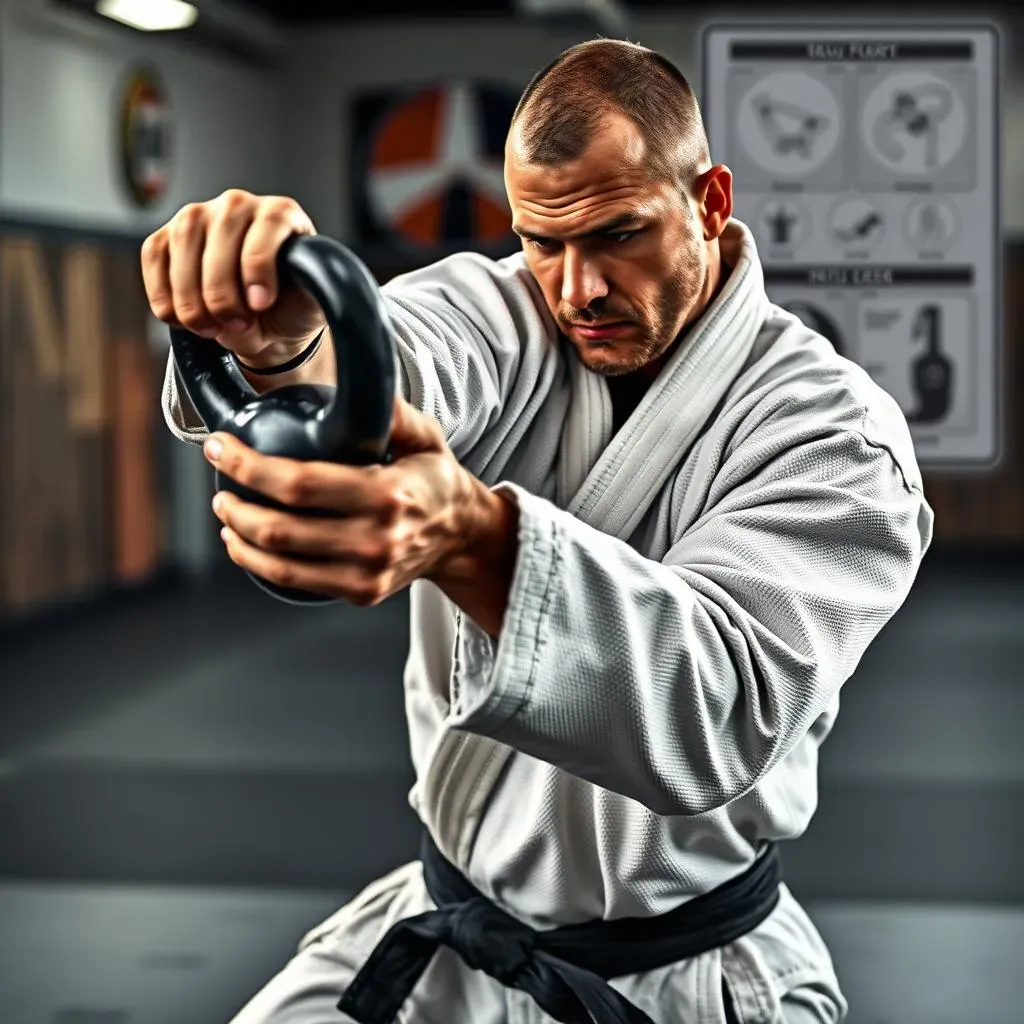Table of Contents
Brazilian Jiu-Jitsu (BJJ) demands a unique blend of strength, power, endurance, and mobility. Are you looking to elevate your BJJ game beyond the mats? The answer might be simpler than you think: kettlebell training. This article dives into the world of kettlebells, revealing how they can be a game-changer for your BJJ performance. We'll explore how incorporating the best kettlebell workout for jiu jitsu can translate to improved functional strength, explosive power, and unparalleled stamina, giving you the edge you need to dominate your opponents.
Kettlebell Benefits for BJJ: Strength, Power, and Endurance

Kettlebell Benefits for BJJ: Strength, Power, and Endurance
Functional Strength for Grappling
BJJ isn't about isolating muscles; it's about using your entire body as a connected unit. Kettlebells excel here. Unlike traditional weightlifting, kettlebell exercises engage multiple muscle groups simultaneously, mimicking the complex movements you perform on the mat. Think about a scramble – are you isolating your bicep? No way! You're using your legs, core, back, and arms in a coordinated effort. Kettlebells train this kind of integrated strength.
Consider the kettlebell swing. This seemingly simple exercise activates your posterior chain (glutes, hamstrings, back) while demanding core stability and grip strength. These are all crucial elements for powerful takedowns, maintaining dominant positions, and escaping submissions. By building functional strength, you're essentially building a stronger, more resilient grappling base.
Explosive Power Development
Power, the ability to generate force quickly, is a critical asset in BJJ. Whether you're exploding into a guard pass, executing a lightning-fast submission, or defending against a powerful opponent, power can make all the difference. Kettlebell exercises, particularly ballistic movements like swings, snatches, and cleans, are fantastic for developing this explosive power.
These exercises train your body to rapidly recruit muscle fibers and transfer energy efficiently. The kettlebell swing, for example, teaches you to generate power from your hips, a crucial element for many BJJ techniques. Kettlebell cleans and snatches further enhance power development by requiring you to move the weight quickly and explosively overhead. The result? You'll be able to generate more force in your movements, making your techniques more effective and your reactions faster.
Benefit | How Kettlebells Help | BJJ Application |
|---|---|---|
Functional Strength | Engages multiple muscle groups simultaneously. | Stronger takedowns, escapes, and positional control. |
Explosive Power | Develops rapid force generation. | Faster submissions, guard passes, and reactions. |
Endurance | Improves cardiovascular fitness and muscular stamina. | Better performance in long rounds and tournaments. |
Enhanced Stamina and Strength Endurance
BJJ matches can be grueling tests of endurance. You need the stamina to maintain your intensity throughout the round and the strength endurance to resist fatigue when muscles are working for extended periods. Kettlebell training offers a potent combination of cardiovascular and muscular conditioning.
Many kettlebell exercises are performed in a continuous, flowing manner, elevating your heart rate and improving your cardiovascular fitness. Moreover, the constant muscle engagement required by kettlebell movements builds strength endurance, allowing you to maintain your strength and power even when fatigued. By incorporating kettlebells into your BJJ training, you'll be better prepared to handle the physical demands of grappling, giving you a significant advantage over your opponents, especially in those late-round scrambles.
Top 5 Kettlebell Exercises for Jiu Jitsu Domination

Top 5 Kettlebell Exercises for Jiu Jitsu Domination
Kettlebell Swings: The King of Conditioning
Let's kick things off with a classic: the kettlebell swing. This isn't just some random exercise; it's a powerhouse move that builds explosive hip drive, strengthens your posterior chain, and torches calories like crazy. Think about it – hip drive is crucial for takedowns, guard passes, and generating power in submissions. The swing directly translates to these movements on the mat. Plus, the grip strength you develop from holding onto that kettlebell is invaluable for controlling your opponent.
To perform it correctly, start with the kettlebell a few inches in front of you. Hinge at your hips, keeping your back straight, and swing the kettlebell back between your legs. Then, explode forward, driving your hips and glutes to swing the kettlebell up to chest height. Focus on using your hips, not your arms, to power the movement. This exercise isn't just about strength; it's about learning to generate power efficiently, a skill that will pay dividends in your BJJ game.
Pro Tip: Focus on a powerful hip hinge and glute squeeze at the top of the swing. Imagine you're trying to launch the kettlebell forward with your hips.
Goblet Squats: Building a Bulletproof Base
Next up is the goblet squat, a fantastic exercise for developing lower body strength and stability. Holding the kettlebell close to your chest while you squat forces you to engage your core and maintain an upright posture. This is crucial for BJJ, where a strong, stable base is essential for resisting takedowns and maintaining dominant positions. Furthermore, the goblet squat improves your squat depth and mobility, which can translate to better flexibility and range of motion on the mat.
To perform a goblet squat, hold the kettlebell close to your chest with both hands. Stand with your feet slightly wider than shoulder-width apart, toes slightly pointed out. Squat down as low as you can while maintaining a straight back and keeping your chest up. Drive through your heels to return to the starting position. Focus on controlling the movement and maintaining good form throughout the exercise.
Turkish Get-Ups: The Ultimate Full-Body Challenge
The Turkish get-up (TGU) is a complex, full-body exercise that challenges your strength, stability, mobility, and coordination. It involves transitioning from lying on the ground to standing up while holding a kettlebell overhead. This exercise is incredibly beneficial for BJJ because it mimics the movements you perform when escaping from bottom positions and transitioning between guards. It builds incredible core strength, shoulder stability, and body awareness, making you more resilient and adaptable on the mat.
The TGU is a complex movement that should be learned in stages. Start by breaking down the exercise into its individual components and mastering each step before attempting the full movement. Focus on maintaining a stable base and controlling the kettlebell throughout the exercise. With practice and patience, the TGU can become a powerful tool for enhancing your BJJ performance.
Sample Kettlebell Workout Routines for BJJ Athletes

Sample Kettlebell Workout Routines for BJJ Athletes
Strength and Power Kettlebell Workout
Ready to build some serious grappling power? This workout focuses on explosive movements to translate to takedowns and submissions. Remember to warm up properly before starting any workout. Dynamic stretching and light cardio is a great way to prepare your body for the session.
This routine should be performed 2-3 times per week with at least one rest day in between. Choose a weight that challenges you while maintaining good form. Focus on explosive movements and controlled descents.
- Kettlebell Swings: 3 sets of 10-15 reps
- Kettlebell Clean and Press: 3 sets of 5-8 reps per arm
- Goblet Squats: 3 sets of 8-12 reps
- Kettlebell Rows: 3 sets of 8-12 reps per arm
Conditioning and Strength Endurance Kettlebell Workout
This workout is designed to improve your cardiovascular fitness and muscular endurance. It focuses on high-repetition movements with minimal rest. Get ready to sweat!
Perform this routine 1-2 times per week on non-strength training days. Use a lighter kettlebell and focus on maintaining good form throughout the workout. The goal is to keep moving for the entire duration with minimal rest.
Exercise | Sets | Reps | Rest |
|---|---|---|---|
Kettlebell Swings | 3 | 20 | 30 seconds |
Goblet Squats | 3 | 15 | 30 seconds |
Kettlebell High Pulls | 3 | 15 per arm | 30 seconds |
Russian Twists | 3 | 20 per side | 30 seconds |
Kettlebell Mobility and Recovery Workout
Don't forget about mobility and recovery! This workout focuses on improving your flexibility, range of motion, and overall joint health. This routine can be performed on rest days or as a warm-up before training.
Focus on controlled movements and deep breathing. Hold each stretch for 30-60 seconds. Listen to your body and don't push yourself too hard, especially if you're feeling sore or fatigued. Kettlebell windmills and halos are excellent movements for improving shoulder and thoracic spine mobility.
Remember: Proper warm-up and cool-down are crucial for injury prevention and optimal performance.
Maximizing Your BJJ Performance with Kettlebell Training

Maximizing Your BJJ Performance with Kettlebell Training
#1: Tailoring Your Kettlebell Training to BJJ-Specific Needs
So, you're ready to integrate kettlebells into your BJJ routine? Awesome! But before you start swinging wildly, let's talk strategy. The key to truly maximizing your BJJ performance with kettlebell training is to tailor your workouts to address the specific demands of grappling. This means focusing on exercises that improve your functional strength, power, endurance, and mobility in ways that directly translate to the mat. Don't just copy some random kettlebell workout you found online. Think about the movements you perform in BJJ – the takedowns, guard passes, sweeps, and submissions – and choose exercises that mimic and enhance those actions.
For instance, if you struggle with explosive takedowns, prioritize kettlebell swings and cleans to develop your hip drive and power. If you find yourself gassing out in long rounds, focus on conditioning circuits with exercises like kettlebell snatches and Turkish get-ups to improve your cardiovascular fitness and muscular endurance. By aligning your kettlebell training with your BJJ goals, you'll get far more bang for your buck and see a noticeable improvement in your performance.
Key Question: What are your biggest weaknesses in BJJ? Use kettlebells to target those areas and turn them into strengths.
#2: Integrating Kettlebells into Your Overall BJJ Training Schedule
Now, let's talk about fitting kettlebells into your already packed BJJ schedule. It's tempting to go all-in and start hammering away at kettlebell workouts every day, but that's a recipe for burnout and injury. The best approach is to integrate kettlebells strategically, complementing your BJJ training rather than competing with it. Consider your overall training load, including your BJJ classes, sparring sessions, and any other strength and conditioning work you're doing. Then, carve out 2-3 days per week for dedicated kettlebell workouts, allowing for adequate rest and recovery in between. On those days, prioritize quality over quantity, focusing on proper form and controlled movements.
Remember, kettlebells are a tool to enhance your BJJ, not replace it. Listen to your body, adjust your training accordingly, and don't be afraid to scale back if you're feeling overtrained. A well-balanced approach that combines regular BJJ training with targeted kettlebell workouts will yield the best results in the long run.
Training Day | Activity | Focus |
|---|---|---|
Monday | BJJ Class (Technique) | Skill Development |
Tuesday | Kettlebell Workout (Strength) | Explosive Power |
Wednesday | Rest or Active Recovery | Muscle Repair |
Thursday | BJJ Class (Sparring) | Application |
Friday | Kettlebell Workout (Conditioning) | Endurance |
Saturday | Open Mat or BJJ Class | Optional Training |
Sunday | Rest | Full Recovery |
#3: Avoiding Common Kettlebell Training Mistakes for BJJ Athletes
Finally, let's address some common pitfalls to avoid when using kettlebells for BJJ. One of the biggest mistakes is prioritizing weight over form. It's tempting to grab the heaviest kettlebell you can find and start swinging it around, but that's a surefire way to get injured. Focus on mastering the proper technique for each exercise before increasing the weight. Another common mistake is neglecting mobility work. Kettlebell training can be demanding on your joints, so it's essential to incorporate regular stretching and mobility exercises to maintain your range of motion and prevent injuries. Exercises like kettlebell halos and windmills are excellent for improving shoulder and thoracic spine mobility.
Also, don't forget about grip strength. Many kettlebell exercises require a strong grip, which is crucial for controlling your opponent on the mat. Incorporate grip-specific exercises like farmer's carries and dead hangs to strengthen your hands and forearms. By avoiding these common mistakes and focusing on proper form, mobility, and grip strength, you'll be well on your way to maximizing the benefits of kettlebell training for your BJJ performance.
Conclusion: Kettlebells – Your Secret Weapon for BJJ Success
Integrating kettlebell training into your BJJ regimen can be a pivotal move towards enhanced performance and resilience. By focusing on functional movements that mimic grappling scenarios, you develop a unique blend of strength, power, and endurance. This translates to improved takedowns, stronger submissions, and increased stamina on the mat. Embrace the power of kettlebells and unlock your full potential in Brazilian Jiu-Jitsu. Your journey to BJJ excellence starts now – pick up that kettlebell and get to work!